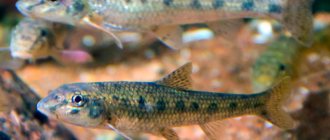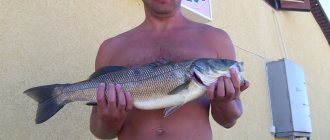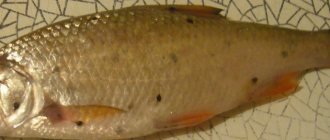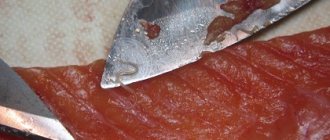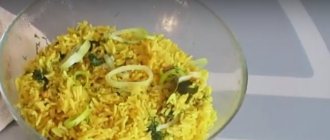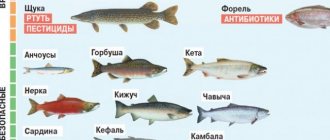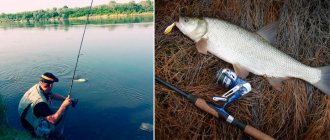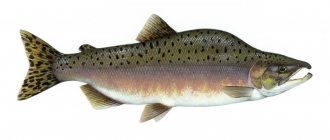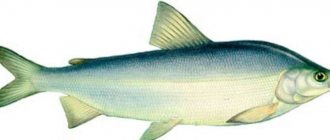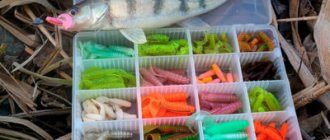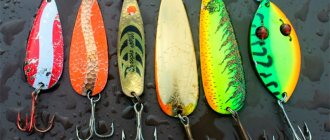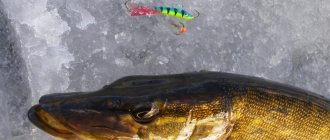Where it lives, what it looks like and description of the species:
Its habitat covers the territory from Central and Southern Siberia to Europe. In Europe, its habitats reach the south of the Pyrenees and the Alps; in Northern Scandinavia, Italy and Greece it is completely absent.
According to the IUCN Red List, this fish is native to the following countries:
Austria, Belarus, Belgium, Czech Republic, Denmark, Estonia, Finland, France, Germany, Italy, Kazakhstan, Latvia, Liechtenstein, Lithuania, Luxembourg, Moldova, Netherlands, Norway, Poland, Russian Federation, Slovakia, Sweden, Switzerland, Ukraine and UK .
Its habitat often coincides with the places where grayling and trout live, like them, it loves rivers with fast currents and rich oxygen content. One of the conditions for its residence is the presence of sandy - gravel soil at the bottom of the reservoir. It does not tolerate cold or warm water well (maximum 28 °C), and is rarely found above 650 m above sea level. Very demanding about the purity of water in the reservoir.
Very rare, but it can be found in small ponds and swamps or even in the coastal brackish water of the Baltic Sea. Can be found in large lakes provided they have access to fresh running water.
The gudgeon is a schooling river and bottom inhabitant of a reservoir; it always lives in a group, being at the bottom of the reservoir. Mainly nocturnal.
There is a subspecies of gudgeon that is found strictly in a limited area, this is the Dniester long-whiskered gudgeon (Gobio kessleri), found only in the Balkans and Eastern Europe, differs from the ordinary gudgeon by longer antennae and noticeable blue spots under or above the lateral line.
Photo of the common gudgeon, side view
Characteristic:
- Carp family, Pescari genus;
- Body size ranges from 8 to 15 cm, the largest recorded specimen was about 20.0 centimeters long and weighed 220 grams. But this is rather an exception, the normal length of his body is about 12.0 centimeters, the maximum body weight is 100 grams;
- The water temperature required for a comfortable life is from 17 to 22 ° C;
- Requires high oxygen content in water;
- The maximum age of life is about 5 – 8 years;
We recommend: What and how to catch burbot
It has a slender, almost round body, a flattened, blunt muzzle with large eyes. The mouth is located at the bottom of the mouth, and a pair of whiskers is located at the edge of the upper jaw.
The color of the back is from dark brown to olive, the ventral side is white, the sides are lighter with a longitudinal row of up to 11 dark, bluish shimmering spots. The dorsal, caudal and anal fins have many small dark spots
Along the lateral line, small flickering spots of irregular shape from bluish to violet are visible.
The scales are quite noticeably shaded by small colored pigments; the fish has a gray metallic sheen. Along the lateral line there are dark gray-blue spots, the fins are relatively transparent.
Photo: Minnow on the bottom, close-up
Description and lifestyle
Gudgeon The common gudgeon has a length of 12–15 cm, in rare cases - 18 cm. The body is elongated, has the shape of a cylinder, and is covered with fairly large scales without mucus. The color is dark gray above, bluish below, with longitudinal stripes and bluish spots on the sides. The dorsal and anal fins are short with dark spots. The mouth is small, with two antennae.
The gudgeon loves rocky or sandy bottoms, which is why it got its name. Minnows prefer to stay in a flock. They lead the most active lifestyle during the day, and spend the nights motionless, resting their lower fins on the bottom.
The gudgeon reaches sexual maturity at 2–4 years. Spawning in April - June is also quite noisy. To do this, it goes to shallow places where it lays larvae directly on the bottom or on plants. Caviar is bluish in color. Only some of the larvae will be able to survive and move to a safer place. The greatest danger to the larvae is the minnows themselves, which devastate the ranks of the young. Minnows grow quickly.
In the first stages of life, minnows feed on daphnia and cyclops. Adults hunt by freezing at the bottom, where they successfully camouflage themselves thanks to their coloration. Their prey includes small invertebrates, mosquito larvae, crustaceans, and insects. In spring, minnows feed on the eggs of other fish.
Lifestyle
The common gudgeon lives in large schools and feeds on bottom-dwelling animals. In the spring, it rises from the wintering grounds from lakes to rivers to lay eggs in May or early June. In autumn it returns to the lakes.
These fish are usually active during the day, but after any encounter with a predator or danger, they may permanently stop going out during the daytime and become completely nocturnal.
Depending on activity level and temperature, and during the breeding season, minnows can make squeaking sounds.
Appearance
The gudgeon has a purely bottom-colored body, which camouflages it on a sandy or muddy bottom between algae. Its back is gray or green-brown in color, its sides are lighter with a yellowish tint. The abdomen practically merges with the color of the bottom sandy sediments - yellowish, sometimes turning into silver. Along the lateral line there are a dozen dark spots of blackish or dark blue color, sometimes they are located so close that they merge into a line built from spots.
The fins are gray-yellow with small dark brown dots arranged in rows. The caudal fin is typically carved. The body is practically devoid of mucus, but the fish is still slippery in the hands. 7-8 pharyngeal teeth on each side are arranged in two rows.
The appearance of the fish varies depending on its habitat. In northern waters, the nose of the gudgeon is sharper; there are individuals without spots on the sides, with strong differences in the color and length of the antennae. Scientists classify individuals with long mustaches as a separate species - the blue minnow.
What does it eat?
A special feature of the gudgeon is that it has a pair of antennae, with which it can feel the bottom and look for food. Its diet consists of small soil animals (worms, crustaceans, insect larvae). Rarely, it can eat the eggs of other fish and plant foods. Does not disdain carrion.
In the wild, it feeds mainly at the bottom, but when kept in captivity, it can be easily accustomed to feeding in different layers of water, the main condition being the absence of predators in the neighborhood.
In winter, unlike some other fish, it continues to actively feed.
Photo: Caught minnow
Feeding
Their antennae play a very important role in finding food for minnows. They help them find crustaceans, worms, cyclops and daphnia, rotted organic matter at the bottom of the reservoir. The main diet in the autumn is bloodworms . There is a hypothesis that bloodworm fish sink to the bottom at the bottom of the reservoir. The gudgeon, with its thick lips, catches the eggs of others (and even its own) from algae or stones, causing considerable damage to the population of other fish. It is believed that he also consumes fish excrement and eats carrion. The gudgeon is an omnivorous fish, but its diet prioritizes animal food.
Fishing:
Almost no one is intentionally fishing for gudgeon, except for some connoisseurs of its meat, which has good taste. For fishermen, the common gudgeon is valuable as live bait for catching pike, pike perch, perch, trout and other predatory fish.
It can be caught both in winter and summer. In winter, you should look for it on lakes that are adjacent to streams, rivers and there is current and oxygen in the water. In summer it can be found in clear rivers and streams with a current and a sandy and gravel bottom.
We recommend: Burbot, where it lives, when to catch it, behavioral characteristics
To catch it, use the following gear: a float rod and small nets - lifts if they are allowed in the fishing areas. It is usually caught in September - October, but you can catch it at any other time.
Catching and value
The fish has no industrial value and is caught primarily for personal consumption. Also used as bait for catching predators. The most suitable tackle is a fishing rod or donka. Takes from late April to November (depending on the region and weather). It is better to catch from sunrise to lunch, while there is no heat.
It takes on various worms, most readily on bloodworms. For fishing, light fishing rods with thin fishing line and small hooks No. 4-8 are used. To attract schools of fish, the water is stirred up - the gudgeon (like the spined lance) goes for it, forgetting about the instinct of self-preservation. This was noticed by many swimmers in rivers.
Reproduction
During the spawning season, this fish often makes short migrations upstream.
During the mating season, minnows communicate with each other and make clearly audible squeaking sounds. Males develop a pinpoint white spawning rash near the head. They become darker in color.
They spawn at night from May to June when the water temperature is around 18 degrees Celsius. A female can lay up to 3,000 eggs per spawning season. Small sticky eggs (size 1.3 - 1.6 mm) are laid in shallow water and sink to the bottom, where they stick to rocks or plants. They do not care or protect their eggs.
Depending on the water temperature, the larvae hatch in 10-30 days. When the yolk sac is used up, the juveniles begin to look for food at the bottom of the reservoir. She prefers weak currents on sandy soils rich in food. They grow very quickly and by the first winter they reach a body length of 5 cm.
At the age of 1-3 years they reach sexual maturity.
Life expectancy is usually 4 to 5 years (maximum 8 years), this age being greatly influenced by the temperature of the surrounding water.
Photo of a minnow in an aquarium
Minnow spawning
The main distinguishing feature of the spawning of gudgeon from other fish is its duration, it is as much as 45–60 days.
Spawning begins when the water temperature warms up to 7 degrees. Accordingly, this happens in the spring, in April - May. These are average data and they depend on both the weather and the region. For example, in central Russia, the gudgeon begins to spawn around the beginning of May. At the same time, the spawning period of roach and perch begins.
The individual becomes sexually mature by the age of 3-4 years. The fish gather in schools, with a proportional number of males and females, and move to shallow water. The female is capable of laying 10,000-12,000 eggs. Caviar has a bluish tint. The egg diameter is 1.3-1.5 mm. The shell of the caviar is sticky; therefore, grains of sand or particles of vegetation easily stick to it, which serve as a kind of camouflage and protect it from being eaten by other fish.
On shallow rivers and streams, weddings take place with noisy splashes. Caviar is deposited in shallow places, on small stones, at a depth of just a few centimeters. Most of the fish's body is constantly protruding from the water, and numerous splashes produce a clearly audible noise. At this time, the gudgeon becomes easy prey for all kinds of predators.
In large rivers, fish spawning is not so noticeable due to the lack of riffles. Shallow places are selected, but the fish remain hidden under water. Here their main enemy is the pike that has already spawned and recovered from the disease.
The life expectancy in the usual habitat of these small predators is 7-8 years. These fish are very tenacious; if you catch a minnow and put it in an aquarium, then with proper care it can live for 2-3 years.
Keeping in ponds and aquariums
The gudgeon is a sociable, peace-loving fish that can be kept both in garden ponds (in countries with mild climates) and in aquariums.
To keep a gudgeon in a pond, it is necessary to provide a water volume of at least 3000 liters and constant filtration, aeration and flow. The pond should have a sandy bottom, where minnows will look for food by digging in the ground, so without a good filter installation, the water will be constantly cloudy.
To winter in a pond, they need depth, usually more than a meter is enough, since ponds are located in warm regions.
This fish is suitable for keeping in ponds only if they meet its requirements for clean water and free areas of land with sand and gravel. It will not live in polluted or overgrown ponds.
We recommend: What and how to catch burbot
Aquarium requirements:
They have been kept in aquariums since the beginning of aquarium farming. For its comfortable maintenance, the aquarium must meet the following requirements:
- Water temperatures range from 15-25°C in summer and around 8°C in winter;
- Lighting about 6-8 hours a day;
- They can be kept in aquariums with a length of 100 cm and a volume of 120 liters;
- The pH of the water should be kept in the range of 7 to 8.
Breeding minnows in captivity
They reproduce well in captivity, subject to certain conditions:
- The ideal water temperature is around 14°C;
- Water pH 7.5.
In the aquarium, it is necessary to provide open areas of sand and gravel where he will look for his food. The aquarium requires regular maintenance, and the presence of cleaning and aeration systems.
Equipment for successful gudgeon fishing
For gudgeon, float rods from three to five meters in length are most often used. The fishing line should be from 0.12 to 0.15 millimeters thick, but it can be thinner. Although, of course, there is a possibility that a larger and more respectable fish, for example, a humpback perch, will accidentally bite, and the fishing line may break.
Minnow catch
But a thick fishing line simply scares small river fish, including the gudgeon, which can also be afraid of the shadow created by a thick fishing line. The float can be supplied either factory-made from plastic or home-made from cork, wood chips, polystyrene foam, etc. The size of the hooks depends on who or what will be attached to it.
If it’s a piece of a worm, then you need a number six or seven, if it’s a bloodworm, a number ten hook is preferable. When casting a fishing rod, make sure that the hook is near the bottom or touches it. Therefore, you should fish at great depths, and not fish on the surface, otherwise you will come across bleaks and not the desired minnows.
If there is an abundance of minnows in a particular area of the reservoir, then two hooks can be placed on the fishing line at once, at a distance of five centimeters from each other. Moreover, the first and main hook should be tied to the end of the fishing line, and the second should be secured with a thin fishing line, which will serve as a leash.
The choice of bait for minnows depends on the calendar month. If it is spring or summer, it is better to plant a caddisfly or a piece of worm. If it is the end of August or the autumn month, then a bunch of bloodworms dangling on a small hook is better. If there are few fish in the area of the reservoir, then it is better to plant a larger piece of worm.
And in the riffles, a small piece of earthworm is best suited. The bloodworm must be inserted so that the sting passes under the head of the larva. Minnows are also caught using maggots and ant eggs, but according to the observations of experienced fishermen, they bite less readily.
Interesting Facts:
- In the past, minnows were prized for their tasty meat;
- They cannot live in polluted water, so it can be a kind of indicator of the degree of pollution of the reservoir;
- Fishing lures with the prefix Minnow imitate the movement of a minnow, since in English Minnow means gudgeon, these lures will be effective on pike and trout;
- This fish can talk, when communicating with each other and during spawning they make squeaky sounds to communicate with each other.
- At the beginning of 1970, a group of minnows was brought to the island of Corsica in the lower reaches of the Gravona River to settle in local reservoirs. Because of this, an eel died in local reservoirs; the cause of its death is considered to be a gudgeon that was infected with the Asian nematode Anguillicolla crassus.
Share link:
